Using eSignature in Lacerte
by Intuit•4• Updated 2 weeks ago
Table of contents:
eSignature is conveniently integrated within Lacerte. For common eSignature questions, click here.
Accessing the eSignature dashboard
eSignature for Lacerte comes with a dashboard to cleanly and concisely manage your eSignature requests. Here's how you can access it:
Option 1
- Select the eSignature Dashboard icon

Option 2
- Select the eSignature Dashboard tab

Option 3
- Go to the E-File menu.
- In the dropdown menu, select Intuit eSignature and then select eSignature Dashboard.
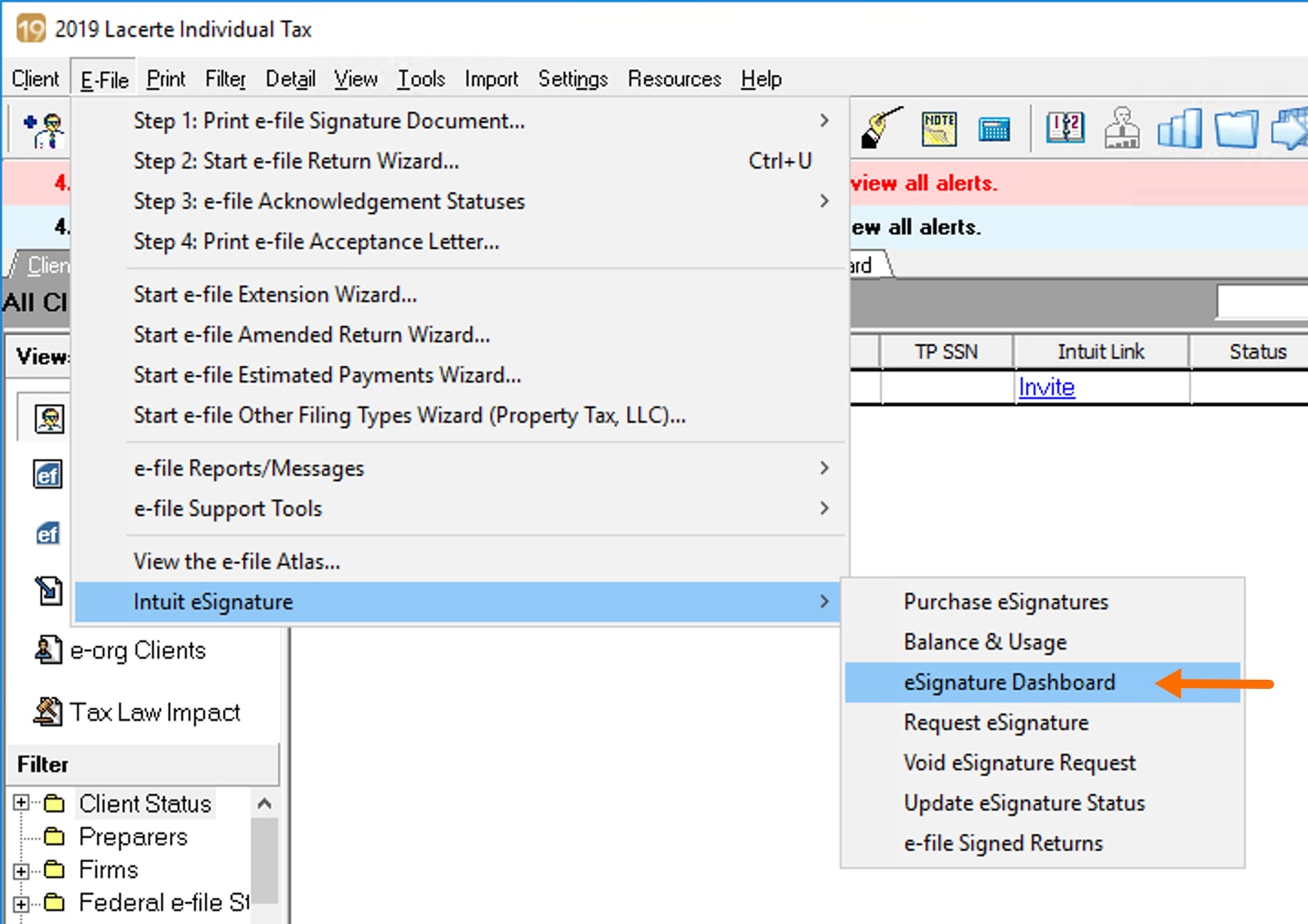
Purchasing eSignatures
- Select eSignature Dashboard tab.
- From the left navigation panel, select Purchase eSignatures.
- Choose Bundle, Unlimited, or Pay as You Go
- For Bundle or Unlimited, enter your Credit Card Information.
- Pay as You Go adds a charge to your next billing statement.
- Click Continue.
- Verify your information on the Preview Order screen and select Continue.
- On the Confirmation screen, you will see your Order Number.
- To return to the eSignature dashboard, click Continue.
![]() Because an eSignature purchase is neither refundable nor transferable—meaning they don't carry over to another tax year—it's advisable to purchase only what you need for the current tax season. Purchases made in the current year can be used for prior-year returns.
Because an eSignature purchase is neither refundable nor transferable—meaning they don't carry over to another tax year—it's advisable to purchase only what you need for the current tax season. Purchases made in the current year can be used for prior-year returns.
Creating email templates for eSignature requests
Create and save multiple email templates to send with client eSignature requests. Or, send specific email messages to subsets of clients, then save them as templates for later use.
To create your custom eSignature email template:
- Go to the E-File menu.
- Select Step 1: Print e-file Signature Document and then Request eSignature in the dropdown menu.
- Select the documents that require an eSignature and click Next.
- Here you can delete or view any document you want to send to your client. Click Next to continue to the Recipients screen.
- In the Email message bar, click the gear icon.
- In the Email templates pop-up window, you can add new email templates, edit, or delete existing templates.
Sending eSignature requests
In order to send an eSignature request to a remote client:
- Under the Client list, highlight the client.
- In the E-File menu, go to Intuit eSignature and select Request eSignature.
- The standard tax forms will be displayed. By default, a copy of the client's return is automatically included in every request. If you don't want to include a copy of the tax return, uncheck the box Include Client Copy of Tax Return.
- Select Next to be taken to the Request eSignature screen.
- Here you can delete or view any document you want to send to your client.
- For instructions on adding documents, see the Sending a request with additional documents section below.
- When you're satisfied with the list of documents, select Next to continue to the Recipients screen.
- Review your client's name and email address for accuracy, and edit the email message they'll receive, if needed.
- Select Next to continue to the reminders and expiration options.
- Check the box next to any reminders you want to send, and press Next to review your request.
- Once you're satisfied with the request details, select Send.
To send an in-person eSignature request:
If you're going to meet with your client in person, you can simplify the signature process by creating the eSignature and having your client sign it on the same computer.
- Highlight the client on your clients list.
- In the E-File menu, go to Intuit eSignature, and select Request eSignature.
- Select the forms for which you need signatures, then select Next.
- SelectNext to be taken to the Request eSignature screen.
- When you're satisfied with the list of documents, select Next to continue to the Recipients screen.
- In the gray TaxPayer bar, select the In-Person option
- Enter the name of the appropriate preparer or firm employee in Name of the person collecting eSignature.
- Select Next to continue to the reminders and payment screen.
- When you're satisfied with your selections, click Next.
- Review your selections on the summary screen, then select Send.
- Once your client is ready to sign, locate them on your eSignature Dashboard.
- Note: Their status will be Pending In-Person.
- Select Collect Now in the action column.
- You'll receive a message that you'll now be taken to DocuSign to collect the signature. Select Ok to continue.
- If the request has multiple recipients, select the person who will sign first, then select Ok.
- DocuSign will open in your web browser. Read the instructions, then select Start.
- Next, give your client control of the computer. Your client should:
- Check the box labeled I agree to use electronic records and signatures.
- Sign the document, then select Finish.
- Enter their email address to request a copy of the completed document, or press Print for a paper copy.
- Select Continue.
- Select Continue once more to pass control back to you.
Once these steps are completed, you can refresh your eSignature dashboard to update the request status.
If there is only one recipient, the status will change to eSignature Completed. If the request has multiple recipients, like an MFJ return, you can have the second person sign now.
Select Collect Now and follow the steps in this section beginning with step 9.
Sending a request with no watermark on the Client Copy
Beginning with Lacerte TY20, you can remove the Do Not File watermark on the Client Copy of the tax return when using eSignature.
- Select a client and then go to the E-File menu.
- Select Intuit eSignature and then Request eSignature from the dropdown menu.
- On the eSignature Forms screen do one of the following:
- Select Watermarked to include a Do Not File watermark on the Client Copy. This option is selected by default.
- Select Non-watermarked to remove the Do Not File watermark on the Client Copy.
- Select Next to continue.
- You can preview the client copy of the tax return on the next screen by clicking View in the in the Actions column.
- Proceed with sending the eSignature request.
Sending a request with additional documents
Before you start:
- Verify the tax return is set up for e-filing on Screen 1.
- Make sure you've completed the return and resolved all critical diagnostics.
- Starting in tax year 2020, the IRS permits electronic signatures on Forms 2848 and 8824.
To send the request:
- Under the Client list, highlight the client.
- In the E-File menu, go to Intuit eSignature and select Request eSignature.
- The standard tax forms will be displayed.
- By default, a copy of the client's return is automatically included in every request.
- If you don't want to include a copy of the tax return, uncheck the box Include Client Copy of Tax Return.
- Select Next to continue.
- Select Start a request to continue to the Request eSignature screen.
- Here you can add, delete, or view any document you want to send to your client.
- To add a document, choose the document type from the dropdown menu, then select Browse to select a PDF from your computer.
- The dropdown option Reference document doesn't require a client signature.
- When you're satisfied with the list of documents, select Next to continue to the Recipients screen.
- Review your client's name and email address for accuracy, and edit the email message they'll receive, if needed.
- Select Next to continue to the reminders and expiration options.
- Check the box next to any reminders you want to send, and select Next to review your request.
- Once you're satisfied with the request details, select Continue to DocuSign so you can insert signature tags on the other documents as needed. A new tab will open that displays the documents you included.
- The documents will be listed on the right-hand side of the page. Select the other document you manually attached.
- Drag and drop the Signature tag(s) located on the left side of your screen to the signature location(s).
- Select the Send button to send the request to your client.
Sending a request using Access Code Authentication
When using Access Code Authentication, you client will be able to authenticate their signature using a code you provide them instead of the traditional Knowledge Based Authentication (KBA) using when requesting signatures.
Before you start:
- The Access Code authentication method can't be used when the Form 8879 or state equivalent is auto-attached to the eSignature request.
- The Access Code authentication method can be used with the following document types:
- Engagement Letter
- 7216 Consent form
- Form 4506-T
- Form W-9
- Other Documents for eSignature
- The preparer must communicate the code to the client separtely, such as via phone or a separate email
NOTE: Don't include the code in the eSignature email.
How to send an eSignature request with the Access Code Authentication method.
- Start the eSignature request wizard
- Select a document type that supports the Access Code Authentication type.
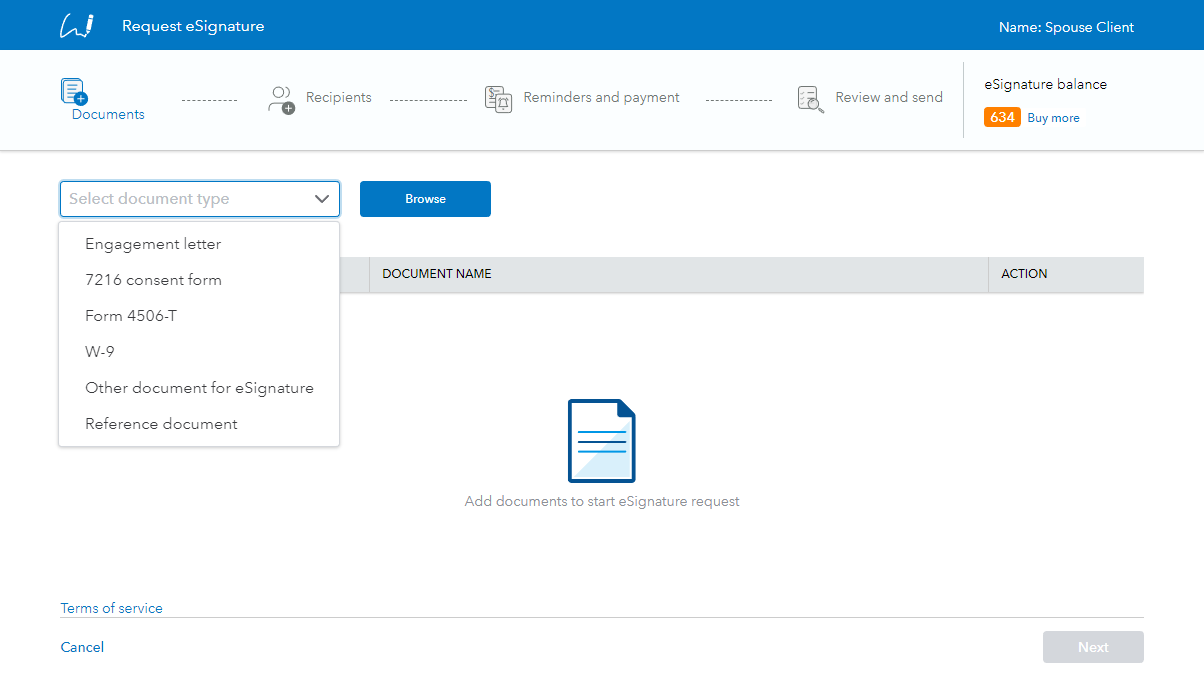
- After selecting the desired documents, click Next.
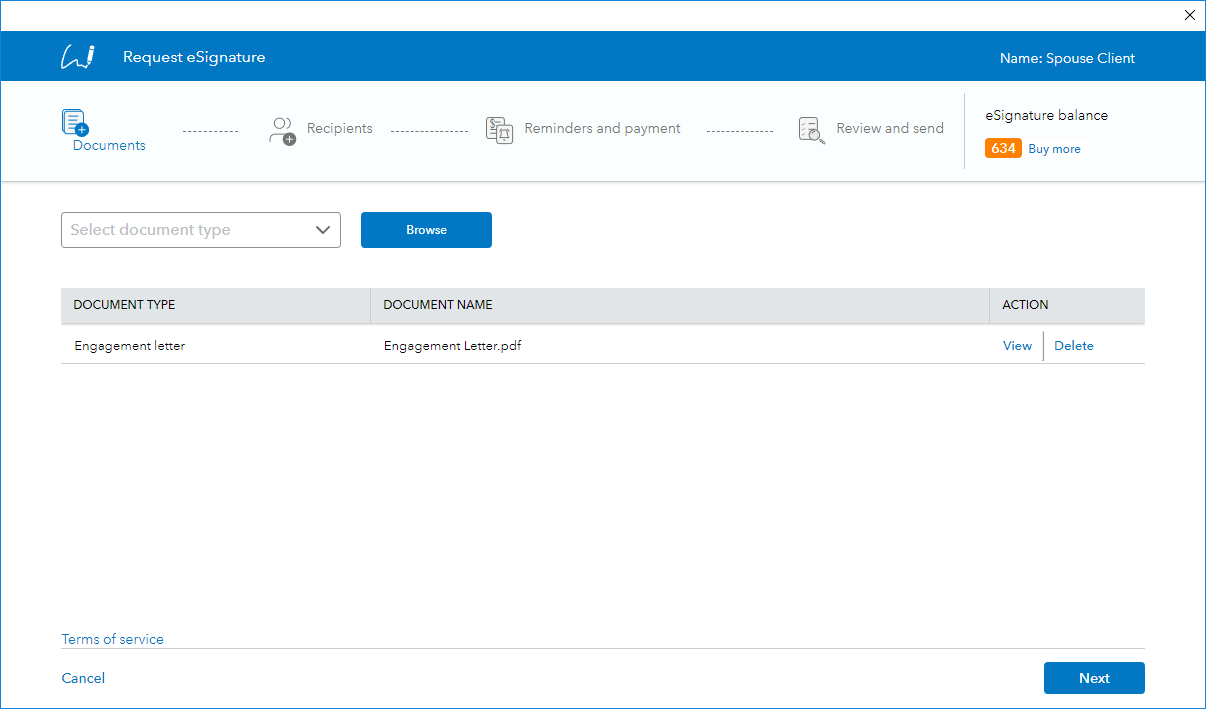
- Select the drop-down arrow in the Authentication Method field and select Access Code.
- NOTE: If the request contains an auto-attached Form 8879 or state equivalent, the authentication method can't be changed.
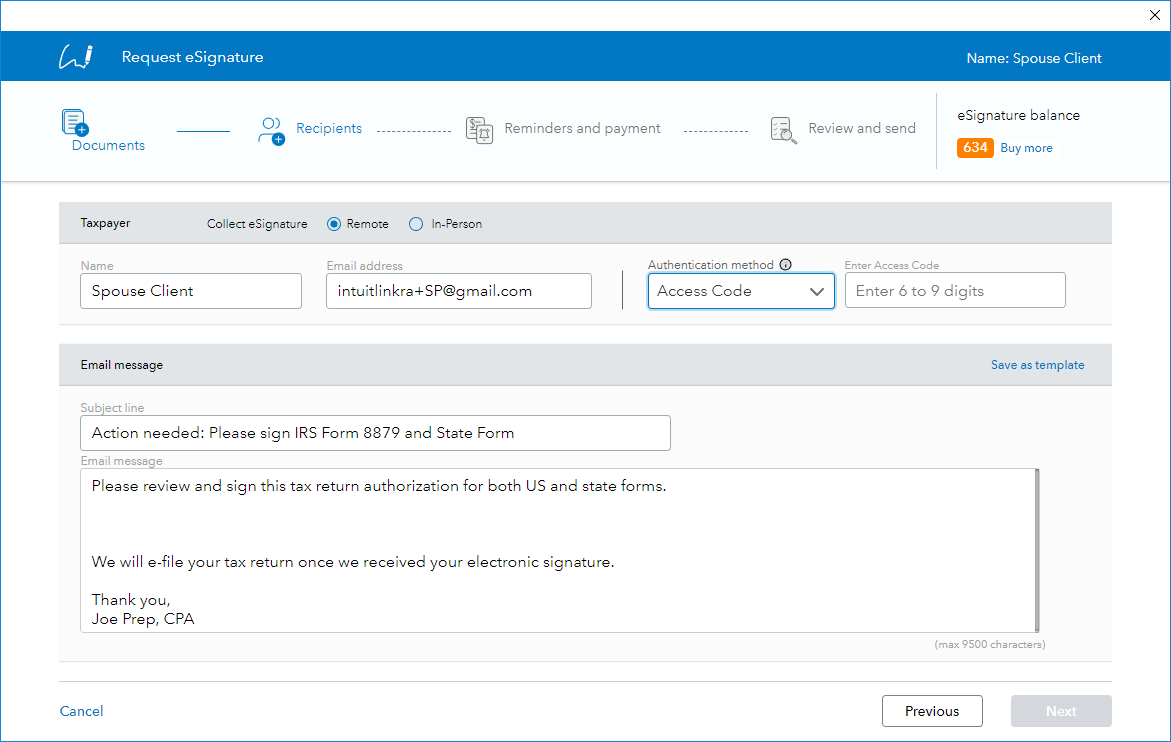
- Choose a 6 to 9-digit code and enter it in the Enter Access Code field.
- Note: You will need to communicate this code to your client for them to sign.

- Select Next to continue.
- Make the desired selections in the eSignature reminders and Expiration screen and select Next.
- Review the eSignature settings on the Summary page and select Continue to DocuSign when ready.
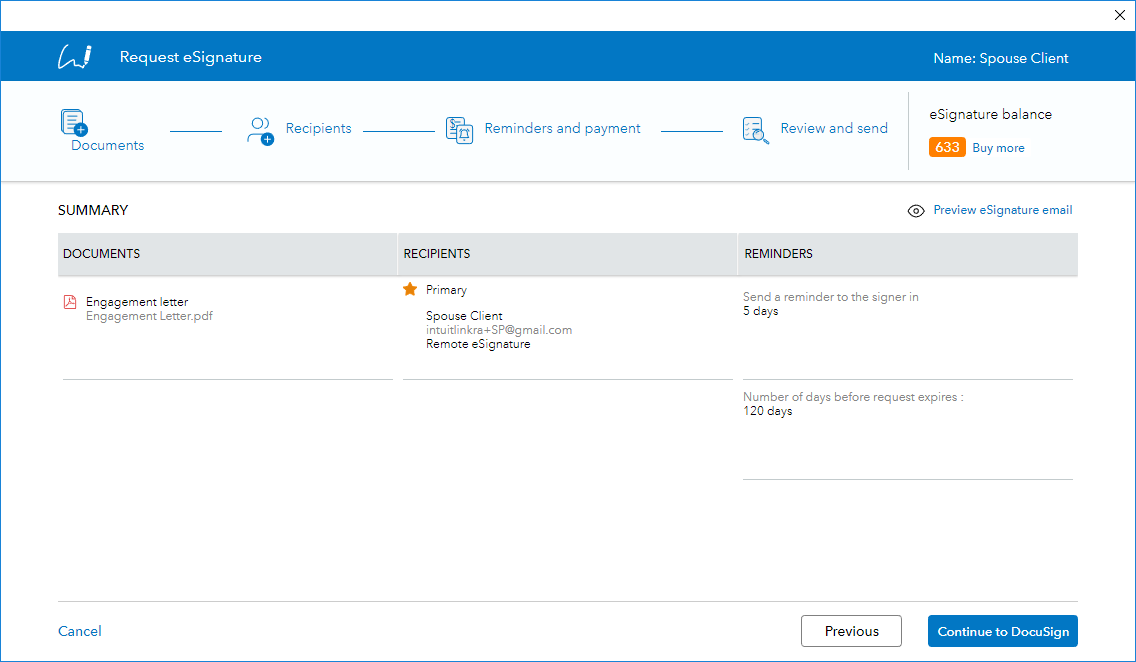
- You will now be taken to DocuSign where you can add the signature tags to the document.
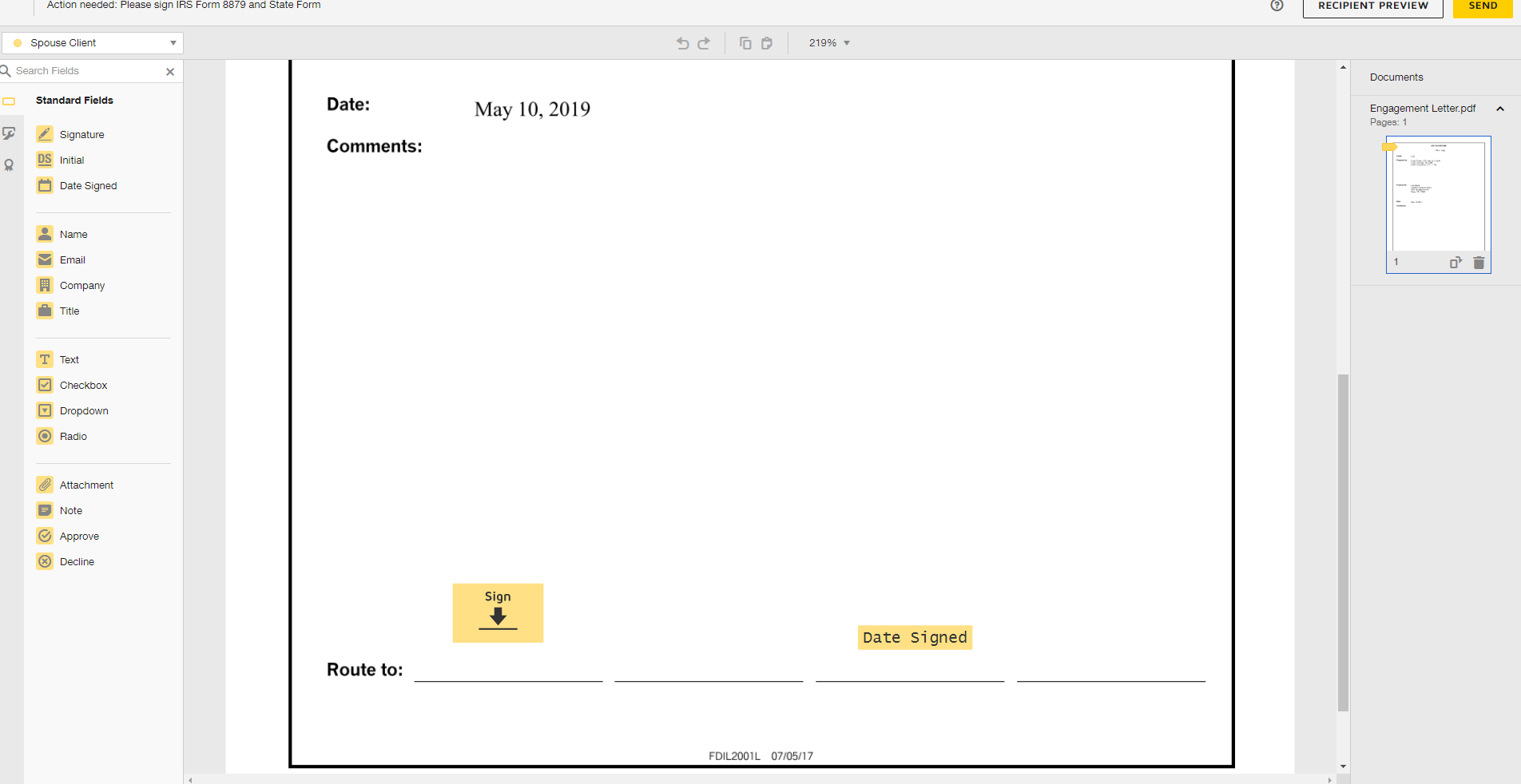
- Once all necessary tags have been added, select Send to email the documents to your client.
The taxpayer, and spouse if filing jointly, will receive the email to review and sign the documents.
- After selecting Review Documents in the email, they will be prompted to enter the Access Code to access the documents
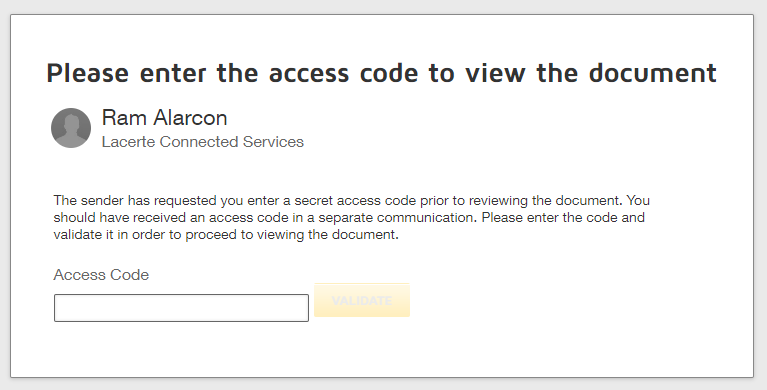
NOTE: They will get 3 tries to enter the correct access code. If the incorrect code is entered 3 times, they won't be able to access the envelope. You will need to void and send a new eSignature request.
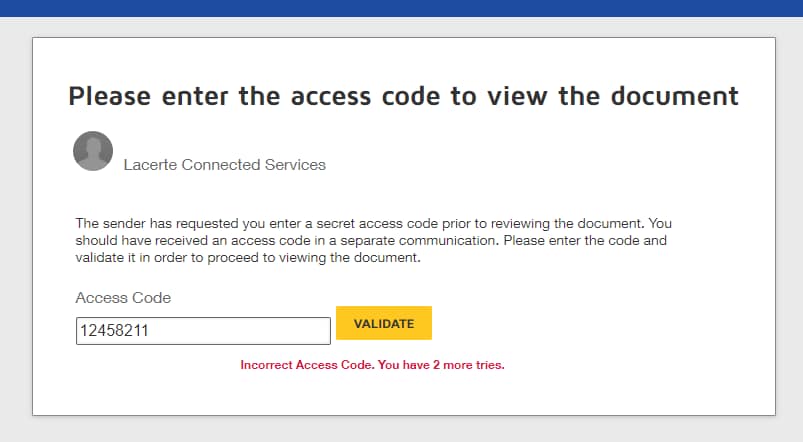
To view and download completed eSignature documents
To view your completed documents:
- Select on the eSignature Dashboard tab.
- Select on Ready to e-file on the Action required card at the top of your screen. Only clients with completed eSignatures will be displayed.
- You can search for a specific client by using the search by client name field and typing in the client's name or email address.
- When all documents are signed, the eSignature status column will show eSignature Completed. To view the signed documents, click the dropdown menu on the Actions column and select View.
- Choose the PDF you want to view.
To download your completed documents:
- To download documents, click Download under the Actions column.
- Select a local folder or network folder in which to save the .zip file.
- Type the name of the file or elect to keep the default name.
- The default format for the name of the file is esign-documents-Client#.zip.
- Select Save.
Canceling an eSignature request
Once a requested eSignature shows Completed status, it can't be canceled. Simply resend a new eSignature request to the client.
There are two ways to cancel an eSignature request:
Option 1
- Go to the eSignature Dashboard.
- Locate the client from the list.
- In the Actions column, select Void Request.
- In the Cancel eSignature Request window, click Confirm.
Option 2
- Under the Client list, highlight the desired client.
- From the E-File menu, navigate down to Intuit eSignature.
- Select Void eSignature Request.
- On the Cancel eSignature Request window, click Confirm.
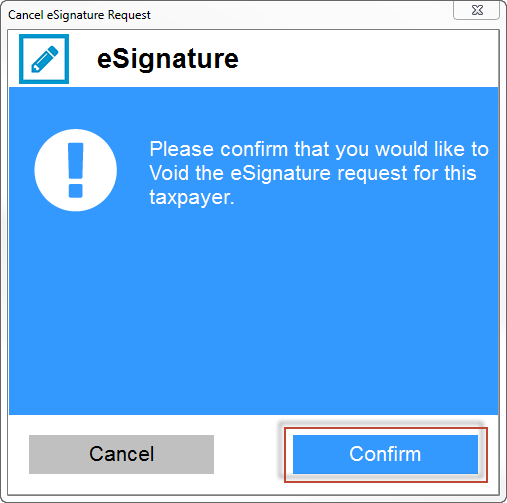
Editing an existing eSignature request
Starting with the 2023 September release, on the eSignature Dashboard you can use Edit to modify an eSignature request after it's been sent. This lets you to change what's in the eSignature request without using an additional eSignature credit. You can change:
- Text in the email sent to the recipient
- Remove no longer needed forms.
- Add new federal or state forms.
- Send updated forms
Note: This does not allow you to edit eSignature Payment Requests.
Edit is available for eSignature requests based on their Status. The following chart will show you if the request is editable:
| Status | Description | Editable |
|---|---|---|
| Sent | The request has been successfully sent. | Yes |
| Delivered | The recipient has opened the request and has logged into Docusign, but has not yet been signed. | Yes |
| In-Process | The request is being setup but has not yet been sent to the recipient. When your ready to continue, select the Resume option. | No |
| eSignature completed | All the recipients signed and returned the eSignature process. | No |
| Partially signed | One of the recipients signed and returned the eSignature process. | No |
| Declined | The recipient declined the eSignature request. A new request can be sent. | No |
| Expired | The eSignature request expired before the recipient took the requested action. A new request can be sent. | No |
| Authentication failed | The recipient failed the autentication check. A new request can be sent. | No |
| Voided | The eSignature requested was Voided. A new request can be sent. | No |
| Pending In-Person | The eSignature is setup for in person signing and has not yet been completed. | Yes |
| Expires in # days | The eSignature request was sent but the recipeint has not completed the request. If not completed in the specified time the request will expire. | Yes |
Adding a secondary email address to receive eSignature confirmations
To add a second email address to receive eSignature confirmations:
- Select the eSignature Dashboard tab and then select How it works on the left panel.
- On the bottom of the screen, click Add Email.
- Select the dropdown arrow to select an email address to receive notifications.
- Select the Add button and then OK.
Why do I only see some users' emails on the pick list and not all users in the firm?
eSignature will only display emails for users who have a Lacerte Admin role. If a user’s email isn't shown on the pick list, that is because they are setup as firm employees. For information on how to change a user’s role, click here.
Can I add more than one firm admin email to receive notifications?
At this time you can only add one email address to receive notifications.
Can each eSignature sender specify a different secondary email address?
You can only have one secondary email address per firm.
Will the secondary email address receive a notification if the client declines to sign or fails the identity check?
Only the sender is notified in either situation. The secondary email address won't be notified in the event that the client declines to sign or fails the identity check. This is by design with DocuSign.
Related topics
You must sign in to vote.


